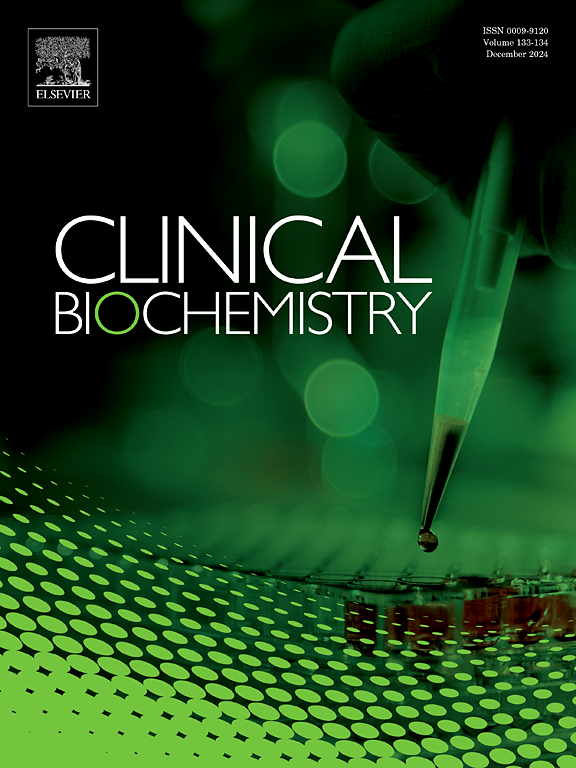Metabolic score for insulin resistance (METS-IR) as a predictor of gestational diabetes: Findings from a prospective Iranian cohort study
IF 2.1
3区 医学
Q2 MEDICAL LABORATORY TECHNOLOGY
引用次数: 0
Abstract
Background
Gestational diabetes mellitus (GDM) represents a significant metabolic challenge in pregnancy, with relevance for Middle Eastern populations showing high prevalence rates. The metabolic score for insulin resistance (METS-IR) has emerged as a potential early predictor, though its performance in Iranian populations remains underexplored.
Methods
In this prospective cohort study conducted at Arash Women’s Hospital, Tehran (2020–2023), we enrolled 1,845 pregnant women during their first trimester (<12 weeks gestation). Participants underwent comprehensive metabolic evaluation including calculation of METS-IR. GDM diagnosis was established at 24–28 weeks using 75-g oral glucose tolerance test per American Diabetes Association criteria. We employed modified Poisson regression with robust variance estimation to assess associations, adjusting for key confounders identified through directed acyclic graphs.
Results
The study population demonstrated a GDM incidence of 19.78 % (365/1845). METS-IR showed strong predictive capacity with area under the ROC curve (AUC) of 0.82 (95 % CI: 0.79, 0.83). At the optimal cutoff of 2.36 (95 % CI: 2.30–2.41), sensitivity reached 72 % (95 % CI: 67, 76 %) and specificity 76 % (95 % CI: 74, 78 %). Adjusted risk ratios revealed a striking dose–response relationship across quartiles: Q2 = 4.21 (2.16, 8.23), Q3 = 8.85 (4.66, 16.78), and Q4 = 18.94 (10.16, 35.29) compared to the reference quartile.
Conclusion
This study establishes METS-IR as a robust early predictor of GDM in Iranian women, demonstrating superior performance to conventional metabolic markers. The simple calculation and strong predictive validity suggest its potential for first-trimester risk stratification in clinical practice, particularly valuable in high-prevalence populations.
胰岛素抵抗代谢评分(METS-IR)作为妊娠糖尿病的预测因子:来自伊朗前瞻性队列研究的发现
背景:妊娠期糖尿病(GDM)是妊娠期一项重要的代谢挑战,与中东地区高患病率人群相关。胰岛素抵抗的代谢评分(METS-IR)已成为潜在的早期预测指标,尽管其在伊朗人群中的表现仍未得到充分研究。方法:在德黑兰Arash妇女医院(2020-2023)进行的这项前瞻性队列研究中,我们招募了1845名妊娠早期的孕妇(结果:研究人群显示GDM发病率为19.78 %(365/1845)。met - ir具有较强的预测能力,ROC曲线下面积(AUC)为0.82(95 % CI: 0.79, 0.83)。在最佳截止点2.36(95 % CI: 2.30-2.41)时,灵敏度达到72 %(95 % CI: 67, 76 %),特异性达到76 %(95 % CI: 74, 78 %)。与参考四分位数相比,调整后的风险比显示四分位数之间存在显著的剂量-反应关系:Q2 = 4.21 (2.16,8.23),Q3 = 8.85 (4.66,16.78),Q4 = 18.94(10.16,35.29)。结论:本研究确立了met - ir作为伊朗女性GDM的可靠早期预测指标,表现出优于传统代谢指标的性能。简单的计算和强大的预测有效性表明其在临床实践中的早期妊娠风险分层潜力,特别是在高患病率人群中有价值。
本文章由计算机程序翻译,如有差异,请以英文原文为准。
求助全文
约1分钟内获得全文
求助全文
来源期刊

Clinical biochemistry
医学-医学实验技术
CiteScore
5.10
自引率
0.00%
发文量
151
审稿时长
25 days
期刊介绍:
Clinical Biochemistry publishes articles relating to clinical chemistry, molecular biology and genetics, therapeutic drug monitoring and toxicology, laboratory immunology and laboratory medicine in general, with the focus on analytical and clinical investigation of laboratory tests in humans used for diagnosis, prognosis, treatment and therapy, and monitoring of disease.
 求助内容:
求助内容: 应助结果提醒方式:
应助结果提醒方式:


